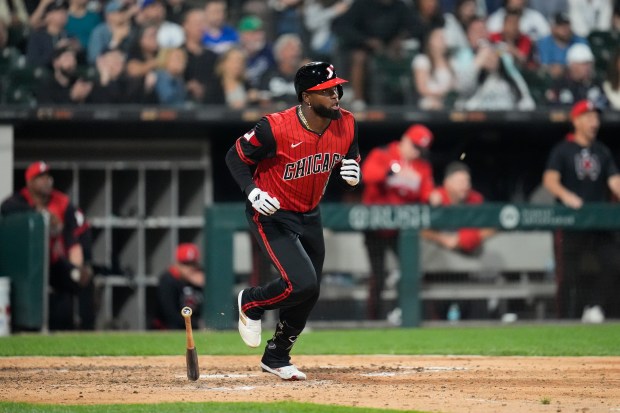New York City Ballet’s long-awaited return to Chicago is a bit like that “how it started, how’s it’s going” internet trend. The first of two programs this weekend is narrowly focused on the NYCB’s first three decades; the second zooms in on this century, with works by Justin Peck, Christopher Wheeldon, Pam Tanowitz and Kyle Abraham.
A couple key milestones contributed to this momentous occasion, which kicked off Wednesday evening with a gala dinner and shorter performance. New York City Ballet celebrates its 75th season this year, brought here by the Harris Theater to commemorate the venue’s 20th year of operation underneath Millennium Park. And the Harris spared no expense, bringing the full company and members of NYCB’s orchestra (under Maestro Andrew Litton’s baton) to Chicago for the first time in 18 years.
That previous visit was also to the Harris as the inaugural performance of Harris Theater Presents. HTP has yielded some of the most thrilling dance to ever grace Chicago stages. Thursday’s program referenced one from 2006, with a pair of early works by NYCB founder George Balanchine and one from Jerome Robbins.
Figuring out when ballet began is an insurmountable and perhaps pointless task. And in this country, where the form’s history is short by comparison (Paris Opera Ballet turns 355 this year), many point to Balanchine as having brought ballet to America. He didn’t; Anna Pavlova toured the U.S. 20 years before Balanchine got here. Ballet was part of the vaudeville circuit, too, tucked in with skirt dances, juggling and minstrelsy decades before the Russian expat uttered, “But first, a school.”
But if you have to start somewhere, “Serenade” is not a bad place. And its opening tableau — a sea of powder blue ballerinas standing in parallel, right arm extended, Tchaikovsky’s “Serenade for Strings” swelling from the orchestra pit — was the perfect place to begin on Thursday evening.
“Serenade,” Balanchine’s first ballet on American soil, was made as a primer on the technique for a group of students in White Plains, New York. Famously, he left in the whoopies he encountered along the way. So at intervals, this ideal specimen of ensemble dancing has ballerinas falling over or missing an entrance on purpose. Like every ballet school, there are not enough men to partner this pack of sylphs, staggering their supported pirouettes with one line of ladies, then quickly moving to another.
Sara Mearns, Miriam Miller and Erica Pereira emerge as the chosen ones, featured in the ballet’s back third as a trio whose long, loose hair swats at Aaron Sanz and Taylor Stanley, mimicking “Serenade’s” signature ankle-length, frothy skirts in motion.
Paired with “The Four Temperaments,” (closing Thursday and Saturday afternoon’s program called “Masters at Work: Balanchine + Robbins”), one gets the clear sense that Balanchine’s legacy is taking “ballet in America” and transforming it into “American ballet.”
In the span of a decade, the hallmarks of Balanchine’s neoclassical zeitgeist emerged. “Four Temperaments” is performed on a blank stage in rehearsal clothes, simple lighting and a spectacular score by Paul Hindemith. There’s a (very) loose connection to ancient medicine’s four humors of the body, but like many things Balanchine made, “Four Temperaments” is all about the dancing and the music. For its time, the ballet pushed technical and aesthetic boundaries. Glimpsing it now, “Four Temperaments” doesn’t exactly read as radical, though its judicious use of flexed hands and leading from the pelvis — humans carving through the stage’s horizontal plane like hieroglyphs — must have felt that way when the piece premiered in 1946.
Tucked between “Serenade” and “Four Temperaments” is Robbins’ “In the Night” (1970). Seen by many as the Gene Kelly to Balanchine’s Fred Astaire, Robbins’ adoration of Frédéric Chopin and midcentury classicism are sometimes forgotten by those more familiar with his Broadway career. Miles from “West Side Story,” “In the Night” is almost hilariously restrained. Robbins assigned three couples a nocturne a piece, all brilliantly realized by pianist Elaine Chelton. It’s almost as though Robbins just wanted to hear the music, giving the dancers a large swath of “In the Night’s” fourth movement — a reprise of “Nocturne Op. 9, No. 2” — very little choreography. They nod and bow toward one another like aristocrats in stiff, uncomfortable clothing. Whatever the opposite of grandiose is — it’s that.
Yet there’s something so paradoxically opulent about “In the Night.” Robbins’ ability to exercise restraint makes each of these resplendent pas de deux shine brighter. Costumer Anthony Dowell’s finery is awash in Jennifer Tipton’s moody ambiance, thanks in large part to the most gorgeous star drop I’ve ever seen twinkling above the dancers’ heads. As with Chelton’s command of Chopin, the dancers (Indiana Woodward and Alec Knight; Emilie Gerrity and Tyler Angle; and Unity Phelan and Andrew Veyette) are entirely at ease, mastering “In the Night’s” distinctly sweet, savory and spicy tones.
The night is about masters, after all. But the real heroes are those dancers, athlete-artists whose presence and stories are as integral to New York City Ballet as Balanchine, Robbins, and that girl who showed up late to Mr. B’s class — a moment she couldn’t have known would be forever enshrined in American ballet.
Lauren Warnecke is a freelance critic.
Review: New York City Ballet (4 stars)
When: Through March 23
Where: Harris Theater for Music and Dance, 205 E. Randolph St.
Running time: 2 hours, 20 minutes with two intermissions
Tickets: $25-$135 at 312-334-7777 and harristheaterchicago.org




